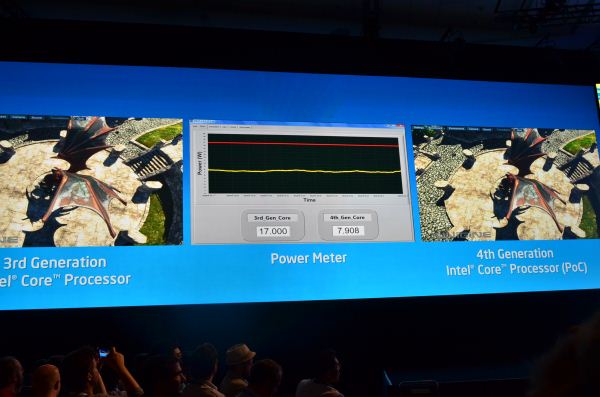Intel's Haswell: 20x Lower Platform Idle Power than Sandy Bridge, 2x GPU Performance of Ivy Bridge
by Anand Lal Shimpi on September 11, 2012 12:58 PM EST- Posted in
- IT Computing
- CPUs
- Intel
- Haswell
- Trade Shows
- IDF 2012
If you've been following our IDF Live Blog you've already seen this, but for everyone else - Intel gave us a hint at what Haswell will bring next year: 20x lower platform idle power compared to Sandy Bridge, and up to 2x the GPU performance of Ivy Bridge.
Intel ran Unigen on a Haswell reference platform at 2x the frame rate of an Ivy Bridge system. Alternatively you could run at the same performance but using half the power on Haswell.











23 Comments
View All Comments
Silver Bullet 126 - Tuesday, September 11, 2012 - link
Hopefully will see this CPU in tablets soon after Ivy Bridge .. maybe even skip IVB and put this in? SC2 on tablet :)Kevin G - Tuesday, September 11, 2012 - link
That's pretty much the plan. There is a limited run of 10W Ivy bridge parts due by the end of this year for tablets so don't expect any high volume product using them. Rather they're mainly for prototyping 10W Haswell products for 2013/early 2014. Still gotta wait.Though if if you think about it, the real tablet chip isn't going to be Haswell but the 14 nm follow up Rockwell. Power consumption will go down slightly but the main benefit will be more IO integration in the SoC. Who needs a chipset?
jaydee - Tuesday, September 11, 2012 - link
Has anyone isolated CPU idle power from the rest of the system? Core i7-3770k ran at 75W idle (whole system) according to the AT review of Ivy Bridge, how much of that do we suppose was the processor?Khato - Tuesday, September 11, 2012 - link
The real question is what exactly Intel means by "20x lower platform idle power". Does the 'platform' simply include processor and chipset? The more it includes, the more impressive the number becomes.A5 - Tuesday, September 11, 2012 - link
It wouldn't shock me if a lot of those gains are in the GPU portion of the chip. When you combine the effort they've put into the GPU + a mature 22nm process, a 20x reduction in idle power for the die seems plausible.A5 - Tuesday, September 11, 2012 - link
To answer the actual question, I doubt that number is taking anything into account that is off of the CPU package. Total system idle would probably drop by 5W or so.tuxRoller - Tuesday, September 11, 2012 - link
If that number is for a laptop, that would be amazing.yankeeDDL - Wednesday, September 12, 2012 - link
I am afraid that this number is mostly marketing smoke.Of course, a large reduction in power consumption is always welcome, and it is certainly an engineering achievement getting a 20x reduction on a platform already as efficient as Sandy/Ivy bridge.
However, Lowering the power consumption from 1W to 0.05W will likely have very limited tangible effect, if at all, given that other components will easily dominate the consumption at that point.
And yes, this is an indication of the CPU+GPU consumption: it says little of the consumption at system level.
Metaluna - Tuesday, September 11, 2012 - link
From what I've read, idle power for the last couple of generations has been pretty low, like 30W or less. Hopefully Intel has learned from its experience with early Atoms that CPU idle power doesn't mean much when the northbridge and other components are still pigs. As idle power drops towards zero, these other components will become even more important.Darkstone - Tuesday, September 11, 2012 - link
'pretty low', 'like 30W or less'.You're pretty far of. Take a look at this dutch blog:
http://ssj3gohan.tweakblogs.net/blog/8217/fluffy2-...
Ivy bridge desktop = 1.56w
arrandale desktop = <3w
The arrandale version is also available in english:
http://ssj3gohan.tweakblogs.net/blog/6112/85w-core...
If you want a power efficient computer. Buy a motherboard with less features or remove your graphics card. The processor doesn't really matter.